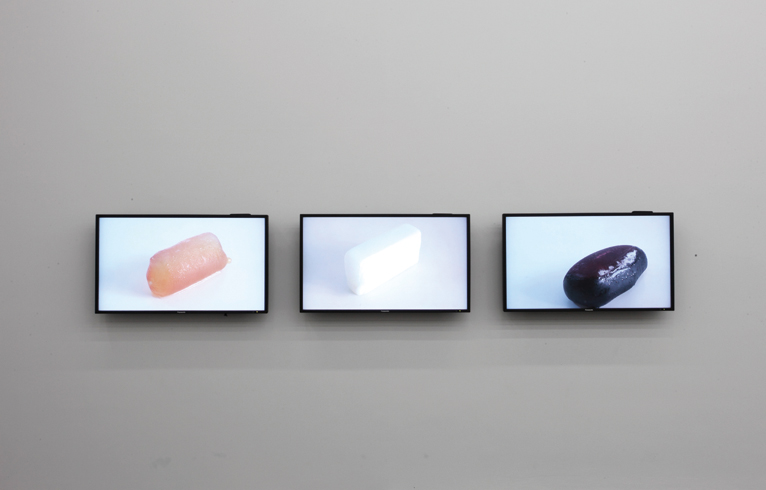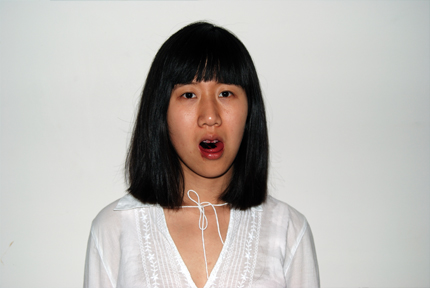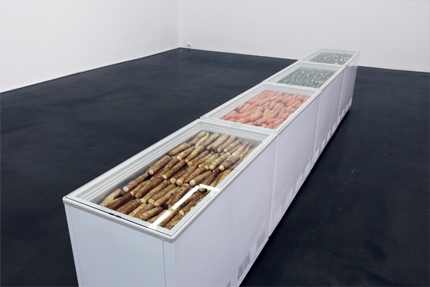THE NEW WORK OF MA QIUSHA: A SYNECDOCHE OF THE EVERYDAY
| May 31, 2012 | Post In LEAP 14

The decision by Ma Qiusha to call her new solo exhibition “Static Electricity” was not one born of careful deliberation. It was made after accidentally coming across the term in a book during an anxious search for a title for her new exhibition. The objects and experiences implied by the term “static electricity” themselves bear no direct relation to her new series of works; rather, the term is itself based on these life experiences, which is a also a venture towards metaphysical vitality. This is the exhibition’s apt synecdoche. A body’s chance encounter with a dim electric light in the dead of winter is fleeting, seemingly trivial and harmless, just like the many elements of the everyday which appear within these new works, placed as they are within a completely new atmosphere and architecture and assigned different points of decipherment and cognitive perspectives. On this occasion, Ma’s creative schematic is entirely abstract. The video and installation works still concern themselves with the human form, although the human body per se is no longer present, instead simplified and abstracted.
The so-called elements of daily life either creep into contemporary art, are consciously avoided, or are emphasized and formed into stylized tendencies. But Ma Qiusha has never avoided “everydayness” within her practice. On the contrary, its various conditions and factors have pervaded nearly all of her output thus far, amply exhibiting her unique sensibility, which to a great degree derives from her application of a synesthetic rhetoric. In her video works From Pingyuanli No.4 to Tianqiaobeili No.4 (2007) and All My Sharpness Comes From Your Hardness (2011), narrative content is maximized from the most bare and simplest of form, such as the knife-blade (in the former a speaking mouth is bloodied by a razor; the latter shows ice-skates being sharpened by a pavement), and the attributes of this everyday object are put to use in powerful rhetorical form, in the process minimizing the hindrance of the medium as an intermediary, instead directly transmitting emotion.

The subtle experiences of daily life conveyed by the body, or by parts of the body, arise repeatedly in previous and subsequent works, mostly expressed as metaphorical postures of a more ambiguous nature. A series of video installations and photographs in which milk persistently appears as a visual element is an example of Ma Qiusha employing the genuine point of departure of abstract rhetoric, whereby (fragmented appearances of) the body and liquid (milk) are both placed within the constitutive make-up of the synecdoche; the milk that flows between the body and its environment constitutes a fragmented approach to representation, rather than presenting the contradiction of bestowed nature and social characteristics.
In the three new video works Red/White/Yellow, this contradictory, abstract rhetoric is taken to a new level. Here, condoms divided according to the bodily fluid they contain— blood, milk, and urine— are shown frozen into blocks, which then gradually melt into liquid at room temperature. However, the videos are sped up to show a process that in fact took several hours. In this durational gaze, the purity achieved by both the white background and overall composition adds greater strength and support to the primary attributes of and ordinary moments surrounding this common object. In order to convey the primary concern for the body, Ma Qiusha explores ideas from various possible points of entry, her apparent infatuation with the surface appearance of various liquids— in fact an intentional focus on bodily fluids— meant to ensure the efficiency of her rhetoric.
Ma Qiusha doesn’t like “fashionable” things. To her, there is still much to be unearthed from fragments of everyday life. The materials and objects she uses are all things she has examined at great length in her daily life. Bestowing ordinary objects with an extraordinary appearance is a deliberate act of dissimilation and abstraction; they thereafter cannot ever return to their ordinary state, and instead form a question posed at the very forefront of the work.
For Ma Qiusha, certain contradictory, interdependent, indistinct and miniscule properties possess a particular vitality. When the materials featured in Red/White/Yellow (bodily fluids) exist in solid form (ice), it is difficult to tell from their appearance that additional properties are contained within: only when they become delicate (as they melt) can their membrane’s (the condom’s) significance be seen. An exchange that can be visually perceived during the shifting of two interconnected states is not alien to Ma: a previous work titled We (2009) later reappeared as Us (2010)— a video performance at Taikang Space in Beijing— showed 100 people in thin white cotton clothing stitched together in the process of tearing themselves away from each other, effectively constructing various metaphors of mutual relations, from small (between lovers) to large (within whole communities). In Ma’s formalized observation the membrane that binds people can possess different states and can determine the similarities and differences between people’s dispositions, as well as their possible relationships to the surrounding environment. But in her current work, the absence of physical human forms actually expands the potential for metaphorical or semantic extension.

In comparison to the vibrant hues of her recent work, the single-screen video projection Souvenir seems drab: steaming animal intestines tossed out of a moving car one by one, rolling down a dimly-lit road at night. The recurring elements of body parts or following an established route, like in older works (such as All My Sharpness Comes From Your Hardness and Gift, among others), are more hyperrealist in implication. But the joyful cooing heard as someone plays with a cat that accompanies the piece is used to jarring effect— viewers who have never had the pleasure of playing with a cat will instead enter one of numerous other interpretative realms. The title Souvenir and its emotive power bring to mind another work, Gift (2009), a necklace made from the false teeth of Ma’s deceased grandmother. Tension is born of the juxtaposition of two elements: an emotionally loaded intimacy and a somewhat vile sensory experience. In this piece, image as a medium that relies on the capacity of time is pushed to its greatest limit.
These kinds of contradictory and interdependent elements are reflected in the artist herself, and furthermore, unwittingly act as an aid to understanding her creative practice. Ma Qiusha— petite, shy, and so well-versed in daily life— admits that she is more daring when speaking through art, as creativity according to her is equivalent to the exchange of language for a genuine voice. What she communicates in her work perhaps exposes to another degree the elements of an oppressed reality that prefer to stay hidden. In other words, her works addresses her own inner thoughts and secrets, and regardless whether or not they want to be exposed, all appear before the viewer. The elements that emerge from within her life, in addition to the images that proceed from the work itself, constitute a complete individual. Perhaps the things we see in her work are actually the genuine Ma? Ma has abandoned such puzzles to us, the viewers, as the direct experience of every single element of her daily shown in her works can be reflected in the viewer, allowing him or her to respectively consider each.

The installation To S emerges transformed by its interconnection with another video piece, as its theme appears more direct and powerful in 3D than on screen. The “receptacle” is presented bluntly, as four freezers, each containing a different kind of vegetable— eggplant, cucumber, yam and carrot— all cut into a uniform shape. The “S” of the title ambiguously refers to “standard,” which conducted as is with such meticulous efficiency, punctures any momentary visual delight with the ruthless erosion of all dissimilarity.
In To S, which comes to us as an installation transformed from video, one can faintly detect Ma Qiusha’s renewed proposal, intentional or otherwise, to uncover the intrinsic being of the tool in use— the image. In one sense, all of her work is imagistic, the often-used “window” employed as a rhetorical vehicle in various scenes to present the various perspectives for viewing conceived by the artist. This also links to One Bedroom, One Living Room, and One Bathroom, which was shown at UCCA in 2011. These depictions of three windows from her childhood home are an early example of the use of a screen from which to examine the world, which could also be seen as a kind of “membrane.” Her recent series of watercolor works on paper titled “Fog” continues this obsession with the membrane, using the common cotton of bungalow fretwork shutters or lower-floor street-facing window as a painting “tool” on which ink is applied in layers to form different decorative designs. Only upon close inspection can one discern that the layers are made up of separate “membranes.” This closely relates to the window as a flat transparent plane: While alluding to simultaneous metaphorical connections between the individual, the family, and the outside world, these very layers become an obscure clue to pondering Ma’s work. Furthermore, in the performance piece Us, which presents a contrast between the falling dusk outside and the brightness of the gallery viewable through a window, the latter undoubtedly also acts as another formal presentation of the image frame, serving to remind us that often the medium of observation that delineates the “membrane” also exists between the observer and thing observed.
Over the past few years, the intrinsic affiliations that have emerged from Ma Qiusha’s work as a whole, especially the rhetorical attempts to dissimilate elements of daily life therein, perhaps originate in her pursuit of unrefined thought processes, and they have also come to form the prime motivation of her creative process. Through her combination of the creative and thought processes, the resultant works are able to wholly embody the latter— including the unresolved and indeterminate elements of the idea— and thus appear fresh and alive. According to her, artistic creation flows naturally from the self, and the work that follows complies with the direction of this flow, developing fresh perspectives and from there alienating the subtle instants and experiences of everyday life in abstract form. In the experiments that make up her creative practice, Ma captures the everyday emotions of many, and more importantly, bravely and in solitude seeks the many decodings of life that lie within her.

